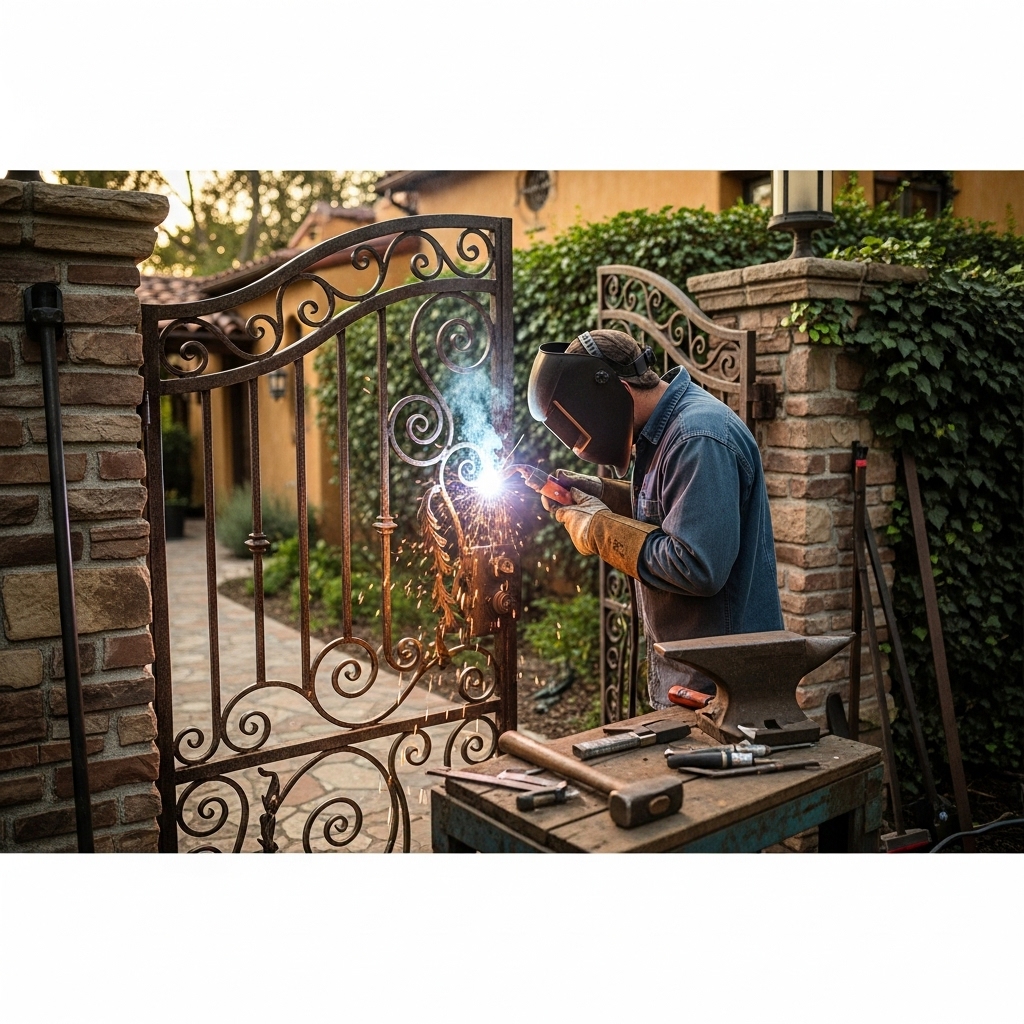Wrought iron gates are part of the visual language of Woodland Hills. You see them framing hillside drives, standing proud at the entrance to Spanish-style homes, and marking property lines along quiet, tree-lined streets. They’re more than barriers; they’re craftsmanship on display. As beautiful as they are, iron gates need steady, knowledgeable care to remain both graceful and strong. That’s where true expertise matters—understanding how metal lives outdoors in our climate, how welds age, and how to preserve finishes so the gate remains the statement piece it was meant to be.
When neighbors ask me what sets an iron specialist apart, my answer is simple: a good eye and patient hands. Anyone can spot obvious damage, but experts notice the hairline crack at a stress point, the slight sway that hints at a loosening hinge barrel, or the early bloom of oxidation under a decorative collar. Those details, caught early, make repair surgical rather than dramatic. If you’re planning professional gate repair, choosing a team that treats your gate like a piece of architecture—rather than just a moving part—makes all the difference.
What iron needs in Woodland Hills
Our Valley’s climate runs the gamut: intense summer sun, dry winds that carry fine dust, and winter rains that seem to arrive all at once. Iron endures, but it records every season if we let small compromises go unchecked. Moisture hides where scrolls meet rails, behind rosettes, and inside hollow sections with poor weep paths. A finish that looks intact from a few feet away may be lifting at an edge, quietly inviting oxidation. The discipline is in probing those points gently, treating what we find, and sealing the work so the cure lasts.
Hinges and posts carry the story of use. If a gate has been opened with a touch of force—say, by a delivery truck nudging it—microscopic shifts can begin at the pin or within the weld that holds the barrel. Over time, that tiny play grows into a visible sag. We correct it by re-establishing plumb, addressing worn pins, and reinforcing weld areas as needed. The result is motion that feels authoritative and smooth, with the latching action you remember from the day it was installed.
Respecting the original design
Wrought iron speaks in patterns—twists, scrolls, spears, and rings. When we repair, we’re not just fixing a mechanism; we’re preserving a design language. Matching picket spacing, bar stock size, and the profile of decorative elements is essential. If a scroll is missing or a spear was bent and cracked, we fabricate to match, not just to fill a gap. This attention ensures the gate looks whole, not patched.
Finish work deserves the same care. Whether your gate wears paint or powder coat, the goal is an even, sealed surface that protects and flatters the metal. In Woodland Hills, where sun is fierce and irrigation is pervasive, we favor prep that includes thorough cleaning, rust neutralization where necessary, and diligent sealing of edges and fastener points. That’s how you get a finish that looks right and stays that way.
Operators and iron: a balanced partnership
Many iron gates are motorized, and the relationship between the operator and the gate is a dance. A slightly stiff hinge or a latch that catches late can make the operator feel underpowered. We always tune the mechanics before judging the machine. Once the gate glides freely and stops where it should, we set force and limit parameters to suit. In Woodland Hills, we also think about wind exposure. A gate that faces a canyon breeze needs settings that account for occasional gusts without tripping safety unnecessarily.
Access control layers—keypads, intercoms, fobs—often live in decorative pedestals or columns near iron entries. We route wiring neatly and protect terminations so the system remains discreet. Your gate should feel like a complete composition, with technology woven in rather than bolted on as an afterthought.
Structural integrity: posts, footings, and hinges
Beautiful iron needs a strong foundation. If a post is loose in its footing or if the footing has cracked from tree roots or soil movement, we address that first. Woodland Hills slopes and soils demand respect; a small lean at the post becomes a big misalignment at the latch. Re-setting a post or reinforcing a footing restores the geometry that lets everything else behave. Hinges, too, deserve precision. We fit, pin, and weld so that motion is authoritative, not tentative.
For double-swing entries, synchronization is everything. Leaves should meet decisively at the center without clatter. We adjust stops, ensure the meeting edges are true, and set operators to deliver a confident, quiet close. It’s the kind of detail your ear notices even more than your eye.
Corrosion control: catching issues early
Iron rewards vigilance. Tiny rust freckles around fasteners or at the base of pickets are invitations to act. We clean, treat, and seal before they become larger stories. Where water collects—beneath decorative collars, inside hollow sections—we create paths to let moisture escape and keep oxygen from feeding hidden corrosion. In irrigated landscapes, redirecting a head by a few degrees can double the life of a finish. Little moves, big gains.
If we encounter deeper rust, we excise thoughtfully, making replacements that are structurally sound and visually consistent. The goal is a gate that feels original, even if we’ve renewed the parts that time challenged most.
Craftsmanship you can see and feel
The proof of expert iron work is in the quiet. A tuned gate opens with confidence and settles into its stop without drama. Latch engagement is crisp, not sharp. The surface reads as a single, protective skin, not a patchwork. When you run your hand along a rail, it’s smooth. When you step back, the symmetry holds.
That experience comes from disciplined process: careful assessment, precise metalwork, conscientious finishing, and a final set of adjustments that lock in long-term behavior. It’s the difference between a repair that simply staves off problems and one that restores pride.
Working neatly, communicating clearly
Iron gates are often front and center, so we plan work to keep your entry presentable throughout. We protect paving and landscape, stage tools to the side, and coordinate with your schedule so access remains simple. If the gate must be secured while finish cures, we provide a plan that maintains security without inviting inconvenience. Throughout, you’ll know what we’re doing and why, with photos or demonstrations where helpful.
Because Woodland Hills homes vary widely—from compact lots to broad properties with long drives—the logistics change from job to job. We’re comfortable on slopes, around tight turns, and near sensitive plantings. Respecting the property is part of respecting the craft.
FAQ: Wrought iron gate repair in Woodland Hills
Q: I see small rust spots around decorative details. Is that serious?
A: It can become serious if ignored. Those are often early signs where moisture lingers. We clean, treat, and seal them so they don’t undermine the finish or the metal beneath.
Q: My double-swing iron gate doesn’t meet cleanly in the middle. What’s wrong?
A: Likely a combination of hinge wear, post movement, or stop misalignment. We re-establish plumb, tune hardware, and adjust operators so the leaves synchronize and meet decisively.
Q: Can you match the original scrollwork if a piece is missing?
A: Yes. We fabricate to match profiles, dimensions, and finish so the repair blends seamlessly with the original design.
Q: The operator seems to strain. Do I need a new machine?
A: Not always. We first reduce mechanical friction—hinges, alignment, latches—then reassess. Many “weak operator” complaints vanish once the gate moves freely.
Q: How do I protect the finish from irrigation?
A: Redirect or shield spray, keep surfaces clean, and address chips immediately. Strategic adjustments to landscaping can dramatically extend finish life.
Q: How often should an iron gate be serviced?
A: An annual check keeps hinges smooth, finishes sealed, and electronics happy. Heavier-use entries benefit from semiannual touch-ups.
Q: Will repairs change the look of my gate?
A: Our aim is preservation. We repair in a way that honors the original design, making changes only where structure or long-term protection requires it.
Ready to restore the elegance of your entry?
If your iron gate has started to chatter, sag, or show the first hints of rust, we can bring it back with craft and care. Reach out to schedule expert gate repair in Woodland Hills—work that respects the artistry of your gate and the daily convenience you depend on.

